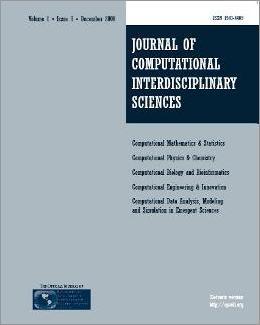
Editorial Office:
Management:
R. S. Oyarzabal
Technical Support:
D. H. Diaz
M. A. Gomez
W. Abrahão
G. Oliveira
Publisher by Knobook Pub


Editorial Office:
Management:
R. S. Oyarzabal
Technical Support:
D. H. Diaz
M. A. Gomez
W. Abrahão
G. Oliveira
Publisher by Knobook Pub
doi: 10.6062/jcis.2008.01.01.0004(Free PDF)
Rolina D. van Gaalen and Mikko Karttunen
A constant supply of glucose is vital for life. Excessive and insufficient amounts can be detrimental to the health of the cell and leads to a variety of complications in the long run. However, due to the polarized nature of glucose molecules, a family of glucose transporters are required for transport across the cell's plasma membrane. In this paper, the glucose transporter protein GLUT1 is studied using two modelling methods: a simple system of differential equations and an object oriented agent-based model. The latter approach incorporates elements of biology and communication between components into the system, yet remains relatively easy to implement. Furthermore, it yields results which are in agreement with both experimental observations and the qualitative observations of more complex mathematical models of other glucose transporters.
Ordinary differential equations, pi calculus, SPiM, glucose transport, GLUT1, stochastic processes, agent-based modelling.
[1] TETAUD E, BARRETT MP, BRINGAUD F & BALTZ T. 1997. Biochemical Journal, 325: 569-580.
[2] WATSON RT, KANZAKI M & PESSIN JE. 2004. Endocrine Reviews,25: 177-204. doi: 10.1210/er.2003-0011
[3] ORBAN JC, DEROCHE D & ICHAI C. 2006. Annales Fraináaises d'Anesthèsie et de Rèanimation, 25: 275-279.
[4] KUMAR S & eds. 2005. Insulin Resistance: Insulin action and its distrubances in disease, 63-78. John Wiley & Sons Ltd.
[5] WOOD IS & TRAYHURN P. 2003. British Journal of Nutrition, 89:3-9 January.
[6] QUTUB AA & HUNT CA. 2005. Brain Research Reviews, 49: 595-617. doi: 10.1016/j.brainresrev.2005.03.002
[7] OBY E & JANIGRO D. 2006. Epilepsia, 47: 1761-1774. doi: 10.1111/j.1528-1167.2006.00817.x
[8] KLEPPER J & LEIENDECKER B. 2007. Developmental Medicine & Child Neurology, 49: 707-716. doi: 10.1111/j.1469-8749.2007.00707.x
[9] PHAY J, HUSSAIN H & MOLEY J. 2000. Surgery, 128: 946-951. doi: 10.1067/msy.2000.109967
[10] MACHEDA ML, ROGERS S & BEST JD. 2005. Journal of Cellular Physiology, 202: 654-662. doi: 10.1002/jcp.20166
[11] YANG Q, GRAHAM T, MODY N, PREITNER F, PERONI O, ZABOLOTNY J, KOTANI K, QUADRO L & KAHN B. 2005. Nature, 436: 356-362. doi: 10.1038/nature03711
[12] GORDON N & NEWTON RW. 2003. Brain and Development, 27:477-480.
[13] GOULD G & HOLMAN G. 1993. Biochemical Journal, 295: 329-341.
[14] PEREIRA LO & LANCHA AH. 2004. Progress in Biophysics and Molecular Biology, 84: 1-27. doi: 10.1016/S0079-6107(03)00055-5
[15] JOOST H-G & THORENS B. 2001. Molecular Membrane Biology, 18: 247-256. doi: 10.1080/09687680110090456
[16] HEMAT R. 2007. Andropathy, 11-16. Urotext.
[17] MOBASHERI A, DOBSON H, MASON S, CULLINGHAM F, SHAKIBAEI M, MOLEY J & MOLEY K. 2005. Cell Biology International, 29:249-260. doi: 10.1016/j.celbi.2004.11.024
[18] ULDRY M, IBBERSON M, HORISBERGER J-D, CHATTON J-Y, RIEDERER B & THORENS B. 2001. The EMBO Journal, 20: 4467-4477.
[19] OLTVAI ZN & BARABÁSI AL. 2002. Science, 298: 763. doi: 10.1126/science.1078563
[20] KITANO H. 2002. Science, 295: 1662-1664. doi: 10.1126/science.1069492
[21] MARLAND ES & KEIZER JE. 2002. In: FALL CP, MARLAND ES, WAGNER JM, TYSON JJ (Eds.) Computational Cell Biology, 53-76. Springer-Verlag.
[22] PHILLIPS A & CARDELLI L. 2007. In: Computational Methods in Systems Biology (CMSB'07), volume 4695, 184-199. Springer Verlag, New York.
[23] PHILLIPS A. (in press). In: Membrane Computing and Biologically Inspired Process Calculi.
[24] PARENT L, SUPPLISSON S, LOO D & WRIGHT E. 1992. The Journal of Membrane Biology, 125: 63-79.
[25] VOET D, VOET J & PRATT C. 2008. Fundamentals of Biochemistry: Life at the Molecular Level, 3rd ed., 295-321. Wiley.
[26] MAKI L & KEIZER J. 1995. American Journal of Physiology, 268:C780-C791.
[27] BAKKER B, WALSH M, TER KUILE B, MENSONIDES F, MICHELS P, OPPERDOES F & WESTERHOFF H. 1999. Proceedings of the National Academy of Sciences of the United States of America, 98: 10099-10103.
[28] LAYTON H & WEINSTEIN A. 2002. Membrane Transport and Renal Physiology, 65-84. Springer.
[29] RUMSEY S. 2007. Australian Family Physician, 36: 571-572.
[30] VAN DYKE PARUNAK H, SAVIT R & RIOLO R. 1998. Multi-Agent Systems and Agent-Based Simulation, 10-25. Springer.
[31] MACY M & WILLER R. 2002. Annual Review of Sociology, 28:143-166. doi: 10.1146/annurev.soc.28.110601.141117
[32] PHILLIPS A. 2006. http://research.microsoft.com/~aphillip/spim/.
[33] CLINE G, PETERSEN K, KRSSAK M, SHEN J, HUNDAL R, TRAJANOSKI Z, INZUCCHI S, DRESNER A, ROTHMAN D & SHULMAN G. 1999. The New England Journal of Medicine, 341: 240-246.